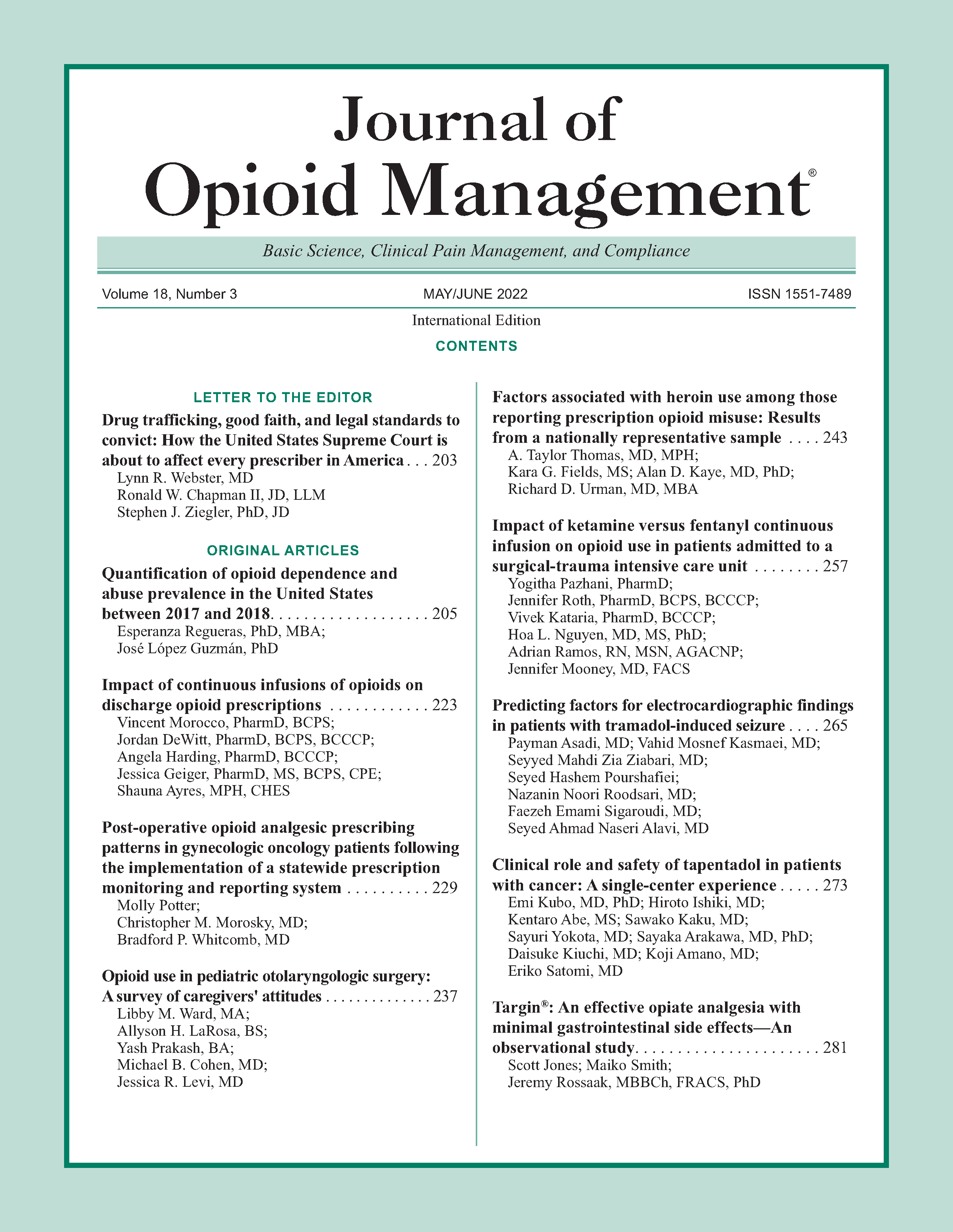Post-operative opioid analgesic prescribing patterns in gynecologic oncology patients following the implementation of a statewide prescription monitoring and reporting system
DOI:
https://doi.org/10.5055/jom.2022.0714Keywords:
opioid prescribing, post-operative pain management, cervical cancer, endometrial cancer, ovarian cancerAbstract
Objective: To analyze the effect of the Connecticut Prescription Monitoring and Reporting System (CPMRS) on the number of opioid tablets prescribed to gynecologic oncology patients post-operatively.
Design/participants: This was a retrospective chart review of patients who received surgery for suspicious masses, premalignant, or malignant conditions of uterus, tubes, ovaries, or cervix. Charts were divided into two groups before and after the implementation of an updated prescription monitoring system in July 2016. Quantitative data were collected on the number of opioids prescribed from hospital discharge summaries. Qualitative data included prescription and/or recommendation of nonopioid analgesics and type of procedure (open versus minimally invasive). Demographic information included age, ethnicity, and insurance coverage.
Outcomes: We identified a statistically significant, 50 percent decrease in opioid tablets in the After July 2016 group (n = 226) compared with the Before July 2016 group (n = 136) (p < 0.001). As anticipated, fewer opioid tablets were prescribed following minimally invasive procedures compared to open cases (p = 0.007). On examining nonopioid analgesic data, we found more patients received a prescription for nonopioid analgesics in the After July 2016 group compared with the Before July 2016 group (p < 0.001).
Conclusion: This study confirms a decrease in opioid tablets prescribed to postoperative gynecologic oncology patients since July 2016. This difference cannot be attributed to the implementation of the CPMRS alone, but chronologically relates to updated requirements. Additionally, our results re-emphasize that minimally invasive surgery has a reduced number of prescribed opioids. A multi-institutional study is required with more patients to detail the factors involved in further decreasing opioid prescribing.
References
Dowell D, Haegerich TM, Chou R: CDC guideline for prescribing opioids for chronic pain—United States. JAMA. 2016; 315(15): 1624-1645.
Dowell D, Haegerich TM, Chouc R: CDC guideline for prescribing opioids for chronic pain—United States, 2016. MMWR Recomm Rep. 2016; 65(No. RR-1): 1-49. DOI: 10.15585/mmwr/rr6501e1.
Overton HN, Hanna MN, Bruhn WE, et al.: Opioid-prescribing guidelines for common surgical procedures: An expert panel consensus. J Am Coll Surg. 2018; 227(4): 411-418.
Mark JE, Phoenix D, Gutierrex CA, et al.: Tackling the opioid crisis: Implementation of an ultra-restrictive opioid prescription protocol in patients undergoing major gynecologic surgery radically decreased dispensed opioid without reducing pain control. Gynecol Oncol. 2018; 149(1): 5.
Prescription Monitoring Program: Connecticut state department of consumer protection. Available at https://portal.ct.gov/DCP/Prescription-Monitoring-Program/Prescription-Monitoring-Program. Accessed November 14, 2018.
Lefkowits C, Buss MK, Ramzan AA, et al.: Opioid use in gynecologic oncology in the age of the opioid epidemic: Part I—Effective opioid use across clinical settings, a society of gynecologic oncology evidence-based review. Gynecol Oncol. 2018; 149(2): 394-400.
Calcaterra SL, Yamashita TE, Min S, et al.: Opioid prescribing at hospital discharge contributes to chronic opioid use. J Gen Intern Med. 2016; 31(5): 478-485.
Nuckols TK, Anderson L, Popescu I, et al.: Opioid prescribing: A systematic review and critical appraisal of guidelines for chronic pain. Ann Intern Med. 2014; 160(10): 38-44.
Brott NR, Peterson E, Cascella M: Opioid, risk tool. In StatPearls [Internet]. Treasure Island, FL: StatPearls Publishing, 2021.
Webster LR, Webster RM: Predicting aberrant behaviors in opioid-treated patients: Preliminary validation of the opioid risk tool. Pain Med. 2005; 6(6): 432-442.
Furlan AD, Hassan S, Famiyeh I, et al.: Long-term opioid use after discharge from inpatient musculoskeletal rehabilitation. J Rehabil Med. 2016; 48(6): 464-468.
Published
How to Cite
Issue
Section
License
Copyright 2005-2025, Weston Medical Publishing, LLC and Journal of Opioid Management. All Rights Reserved.











